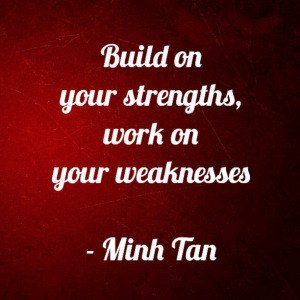 “Since hiding weakness is a burden, some people resort to declaring it openly. They confidently say `I don’t know’ or `I am weak in this’ and thereby lessen the expectations. But is that the right approach?”
“Since hiding weakness is a burden, some people resort to declaring it openly. They confidently say `I don’t know’ or `I am weak in this’ and thereby lessen the expectations. But is that the right approach?”
Follow Dr. Raj on Twitter @drraj29
It is true that every professional fresher or experienced carries a set of strengths and a set of weaknesses. Some may be aware of the same and some may not be in the know readily. Many authors suggest that we must discover our strengths and play to it. It’s true; such strategy works very well and it does give professional success.
However, it is also true that we think about our weaknesses more than our strengths (Yes, you can pause at this moment and think for yourself)! The areas that we are not good at keep haunting us. They affect our confidence. They hold us back in our professional endeavors.
Approaches to deal with weaknesses:
While we are aware of our weaknesses and we know that they affect our professional and personal life, what do we do to deal with them? I notice the following approaches to deal with the weaknesses.
A) Hide your weakness
B) Declare your weakness
C) Work on your weakness
D) Ask for help
At this stage, you are most likely thinking about yourself; you are wondering which of the above approaches do you adopt in dealing with your weaknesses. While it is true that you must be following different methods at different situations, it is important to study if there is one approach that you use more often than others. Accordingly, you can decide if you wish to bring about some changes in dealing with your weaknesses.
Pros and Cons of the methods:
Each of the above approaches bring with them some advantages and associated challenges.
A) Hide your weakness:
Most often adopted approach is to hide one’s weakness. It comes very naturally. It is almost instinctive to wear a mask and cover-up the weaknesses. Take for example a conversation in which the other person is almost assuming that you know the subject and flowing with the topic.
Though you don’t know the topic, you act as if you know it and try managing the situation. To your misfortune if the conversation on the topic were to continue, your weakness will get exposed. Obviously, you are in a hurry to conclude the conversation and move away! Therefore, it is clear that hiding your weakness is possible if the relationship is transitory and not prolonged. If you attempt this approach at workplace where your colleagues see you everyday, you will be mostly seen as a fake personality!
B) Declare your weakness:
Since hiding weakness is a burden, some people resort to declaring it openly. They confidently say “I don’t know“ or “I am weak in this“ and thereby lessen the expectations. They instantly feel lighter because others will not expect anything in the areas of their weakness. For example, I hear some saying, “I am very bad with numbers“.
Such an approach does sound genuine and does work for its honesty. However, the flip side is that you will not work on the weakness because you have already managed the expectations. You tend to live with your weakness.
C) Work on the weakness:
This is a practical approach and healthy when used in conjunction with “Declaring weakness“. In other words, you first admit that you don’t know and then you will strive to improve in the areas of your weakness. It will add to your credibility professionally.

For example, if someone says, “I don’t know how to use excel, but give me a few days for me to learn“, wont you like that person?
D) Ask for help:
This is also a good approach in some situations, especially after you exhausted (B) and (C). That is, you admitted your mistake and tried improving. If it did not work, one should not feel shy in seeking help. That is the only way to deal with your weakness. Imagine yourself not asking for help; you are most likely to go back to (A) that is hiding the weakness!
Look back at your professional or personal experiences; reflect how you tend to react and approach your weakness. Change your approach if it is not working. Remember one thing mishandling of weaknesses will surely hamper your professional development and damage your professional credibility.
This article was published in:
HR Mirror
Hans India
Follow us on Twitter @hrfootprints



